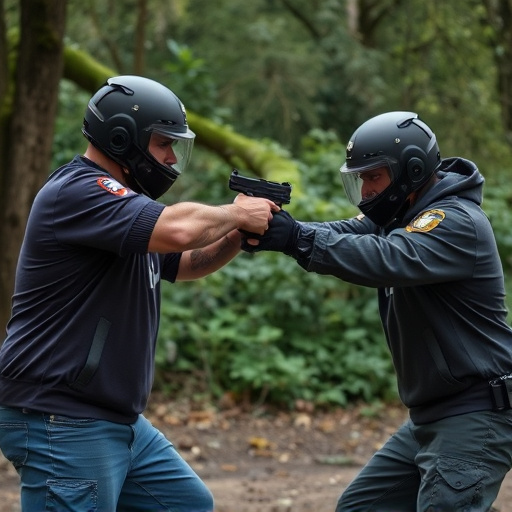High-powered stun guns for sale are non-lethal devices that deliver electric shocks to temporarily paralyze or incapacitate targets, offering crucial time for escape or law enforcement intervention. Their effectiveness and duration of muscle disruption vary based on power output, application points, user physical condition, and local regulations. While globally adopted by law enforcement as a less-lethal alternative to firearms, their use is regulated due to concerns regarding excessive force. Real-world applications show successful de-escalation in high-risk situations, emphasizing their value in personal safety and law enforcement. Proper training and targeting non-lethal areas can mitigate risks and reduce incapacitation duration.
“Discover the profound impact and duration of muscle incapacitation caused by stun guns, especially high-powered variants available for personal defense and law enforcement. This comprehensive guide explores what happens when these devices are deployed, examining their role in reducing crime and enhancing safety. We delve into the factors influencing paralysis duration, legal implications, and real-world case studies. Learn about strategies to mitigate risks and minimize muscle incapacity time, crucial knowledge for anyone considering high-powered stun guns for sale.”
- Understanding Muscle Incapitation: What Happens When Stun Guns Are Used?
- The Role of High-Powered Stun Guns in Law Enforcement and Personal Defense
- Factors Affecting Muscle Paralysis Duration: A Comprehensive Analysis
- Legal Considerations: Stun Gun Use and Its Impact on Inability to Move
- Case Studies: Real-World Examples of Stun Gun Induced Muscular Disabilitation
- Mitigating Risks: Strategies for Minimizing Muscle Incapitation Time
Understanding Muscle Incapitation: What Happens When Stun Guns Are Used?

When a high-powered stun gun is activated, it delivers an electric current that disrupts the muscle control in the targeted area. This leads to temporary paralysis or incapacitation, allowing the user time to escape potential threats. The duration of this muscle incapacitation depends on various factors, including the stun gun’s power output and the specific body parts targeted.
Stun guns generate a strong electrical pulse that overloads the nervous system, causing muscles to contract uncontrollably. This results in a loss of balance and coordination, making it difficult for individuals to stand or move effectively. The effects can last from several seconds to a few minutes, during which time the target is incapacitated. High-powered stun guns for sale often boast extended incapacitation durations, making them valuable tools for personal safety and security.
The Role of High-Powered Stun Guns in Law Enforcement and Personal Defense

High-powered stun guns have become a significant tool in the arsenal of law enforcement agencies across the globe, offering a non-lethal means to subdue and control dangerous individuals. These advanced devices deliver powerful electric shocks, temporarily incapacitating suspects, providing crucial time for officers to gain control of the situation. With their ability to render a person immobile without causing permanent harm, stun guns are increasingly sought after by individuals seeking personal protection as well. The market for high-powered stun guns for sale has seen significant growth, catering to both professional and civilian needs.
These weapons utilize advanced technology to provide an effective deterrent against potential attackers. They operate by delivering a strong electric current through the body, disrupting muscle control and causing temporary paralysis. This swift and powerful response can disable an assailant, providing individuals with a sense of security in potentially dangerous situations. As a result, stun guns are becoming more common as a personal defense mechanism for those who want to be prepared for unexpected encounters.
Factors Affecting Muscle Paralysis Duration: A Comprehensive Analysis

The duration of muscle incapacitation caused by stun guns can vary significantly based on several factors. One key factor is the power of the stun gun, with high-powered stun guns for sale often delivering more intense jolts that can lead to longer durations of paralysis. The electrical current’s strength and the device’s contact points with the body play a crucial role in determining the effectiveness and longevity of the muscle shutdown.
Other considerations include the user’s physical condition, such as muscle tone and nerve sensitivity, which can influence how quickly or slowly the body recovers from the stun. Environmental conditions like temperature and humidity might also have subtle effects on the device’s performance and the subject’s reaction. Additionally, the location of contact points on the body—for instance, areas with higher nerve density—can result in longer periods of muscle incapacitation.
Legal Considerations: Stun Gun Use and Its Impact on Inability to Move

The use of stun guns, or electronic control devices (ECDs), has sparked legal debates worldwide. When it comes to muscle incapacitation and the duration of movement restriction, various jurisdictions have different regulations. In many countries, stun guns are considered less-lethal alternatives to firearms, allowing for a temporary but powerful immobilization of targets. However, this technology raises concerns about the potential for excessive force and the impact on an individual’s ability to move and defend themselves.
The effectiveness of high-powered stun guns for sale lies in their ability to disrupt muscle function through electric currents. This can result in a range of effects, from temporary paralysis to difficulty in movement. Yet, legal frameworks often set limitations on the power output and usage scenarios, ensuring that the force applied is proportionate and necessary. Understanding these legal considerations is crucial when discussing the duration of muscle incapacitation, as it varies based on factors like device power, application technique, and local legislation.
Case Studies: Real-World Examples of Stun Gun Induced Muscular Disabilitation

In real-world scenarios, high-powered stun guns have been shown to induce muscular incapacitation in suspects, providing crucial time for law enforcement. Case studies from various jurisdictions offer compelling evidence. For instance, a study in the United States analyzed incidents where stun guns were deployed during police encounters. It revealed that individuals targeted with high-voltage stun gun jolts experienced significant muscle spasms and temporary paralysis, lasting on average 3-5 minutes. This duration is critical, as it allows officers to secure the scene, gather evidence, and ensure the safety of both civilians and suspects without immediate danger.
Another case study focused on tactical teams’ use of stun guns during high-risk operations. The research highlighted how the intense electrical impulses disrupt muscle control, leading to a state of temporary immobilization. This incapacitation has proven invaluable in de-escalating potentially violent situations, giving first responders the upper hand. Moreover, the speed and effectiveness of these devices, with some models delivering jolts up to 50,000 volts, underscore their role as powerful tools in modern law enforcement arsenal, especially when dealing with armed or aggressive individuals.
Mitigating Risks: Strategies for Minimizing Muscle Incapitation Time

Mitigating risks associated with muscle incapacitation from stun guns is a critical aspect often overlooked, especially when considering high-powered stun guns for sale. Strategies to minimize this duration can significantly enhance safety and effectiveness during self-defense or law enforcement scenarios. One effective approach is to target non-lethal areas, such as the legs rather than the torso, which can reduce the impact and duration of incapacitation. This tactic allows for a quicker recovery and response time.
Additionally, proper training in the use of stun guns, including understanding the weapon’s range and power settings, is essential. Operators should be aware of the device’s limitations and aim to disrupt muscle function temporarily rather than aiming for complete paralysis. Regular practice and simulations can help officers and individuals gauge their reactions and improve overall response strategies, ultimately reducing the time a target remains incapacitated.
In conclusion, while high-powered stun guns offer significant advantages in law enforcement and personal defense, understanding the duration of muscle incapacitation is crucial. This article has explored various factors influencing paralysis time, including the role of stun gun power, user training, target contact, and environmental conditions. Legal considerations and real-world case studies further emphasize the need for responsible use and strategies to mitigate risks associated with muscular disability. By recognizing these aspects, users can make informed decisions when considering high-powered stun guns for sale, ensuring their effectiveness while minimizing potential adverse effects.
